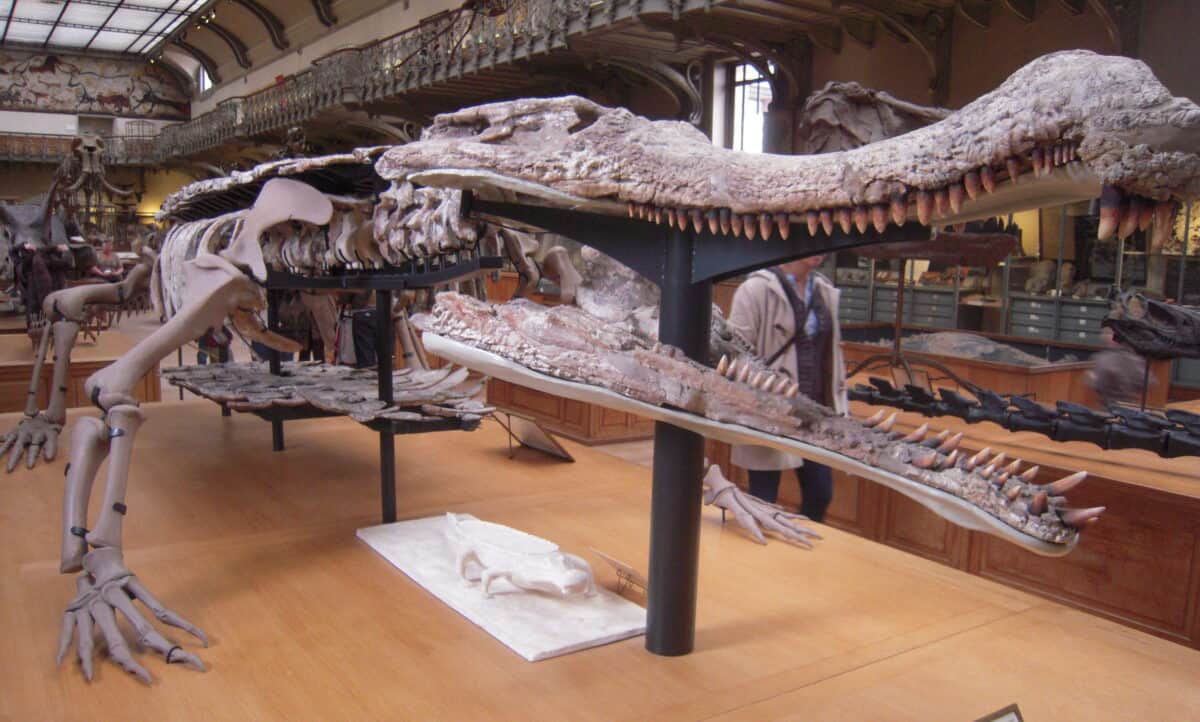In the annals of paleontological discoveries, few findings have generated as much awe as the unearthing of Sarcosuchus imperator, commonly known as “SuperCroc.” First discovered in the Sahara Desert during expeditions in the 1940s and 1950s, it wasn’t until the 1990s and early 2000s that more complete specimens were excavated by a team led by paleontologist Paul Sereno.
These fossils revealed a prehistoric predator of mind-boggling proportions—a crocodilian that grew to an estimated length of 39-40 feet (12 meters) and weighed approximately 8-10 tons. This discovery shattered previous conceptions about the maximum size crocodilians could reach and opened a new chapter in our understanding of prehistoric apex predators.
Sarcosuchus: The Prehistoric Monster
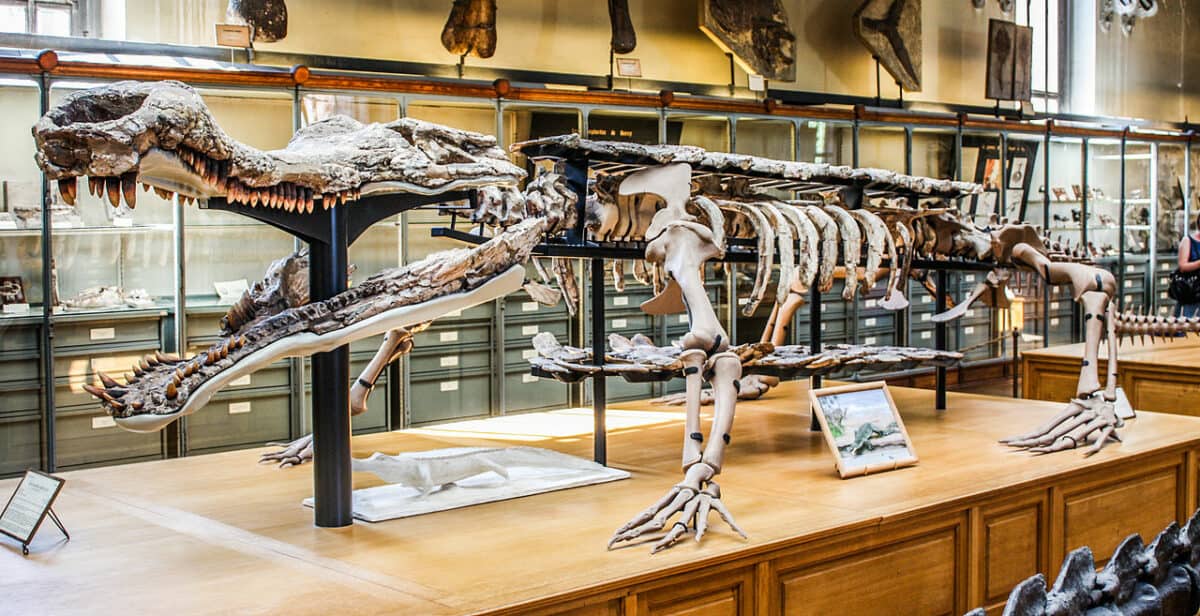
Sarcosuchus imperator, whose name translates to “flesh crocodile emperor,” roamed the Earth during the Early Cretaceous period, approximately 112 million years ago. Unlike modern crocodiles, which typically reach lengths of 14-17 feet at maximum, Sarcosuchus was nearly three times larger than today’s largest crocodilian specimens.
Its skull alone measured over 6 feet (1.8 meters) in length—longer than many humans are tall. This massive crocodilian wasn’t just a scaled-up version of today’s crocodiles; it possessed unique adaptations that made it perfectly suited for its environment and hunting style. The fossil record indicates that Sarcosuchus had a slight overbite and a bulbous growth at the end of its snout called a bulla, which may have been used for vocalization or as a sensory organ to detect prey.
Size Comparison with Modern Crocodilians

To truly appreciate the enormity of Sarcosuchus, we must compare it to today’s largest crocodilians. The saltwater crocodile (Crocodylus porosus), currently the largest living reptile, can reach lengths of 17-23 feet (5.2-7 meters) and weigh up to 2,200 pounds (1,000 kg) in exceptional specimens. The American alligator (Alligator mississippiensis) typically maxes out at around 14 feet (4.3 meters).
In stark contrast, Sarcosuchus stretched to nearly 40 feet (12 meters)—almost twice the length of the largest saltwater crocodile ever recorded—and weighed as much as five full-grown saltwater crocodiles combined. If placed side by side, a modern saltwater crocodile would appear almost diminutive next to the colossal Sarcosuchus, similar to how a house cat would look beside a tiger.
The Habitat and Environment of Sarcosuchus

During the Early Cretaceous period when Sarcosuchus thrived, the regions of northern Africa where its fossils have been found were vastly different from today’s arid Sahara Desert. Paleoenvironmental evidence suggests that this area was once a lush, humid ecosystem with extensive river systems and floodplains.
This ancient ecosystem supported a diverse array of wildlife, including large dinosaurs like Spinosaurus and Carcharodontosaurus, which may have occasionally competed with Sarcosuchus for territory and prey. The massive crocodilian likely spent most of its time in and around freshwater environments, similar to modern crocodiles, but on a much grander scale. Its size would have allowed it to take down virtually any animal that came to drink at the water’s edge, making it one of the most formidable predators in its ecosystem.
Hunting and Feeding Habits
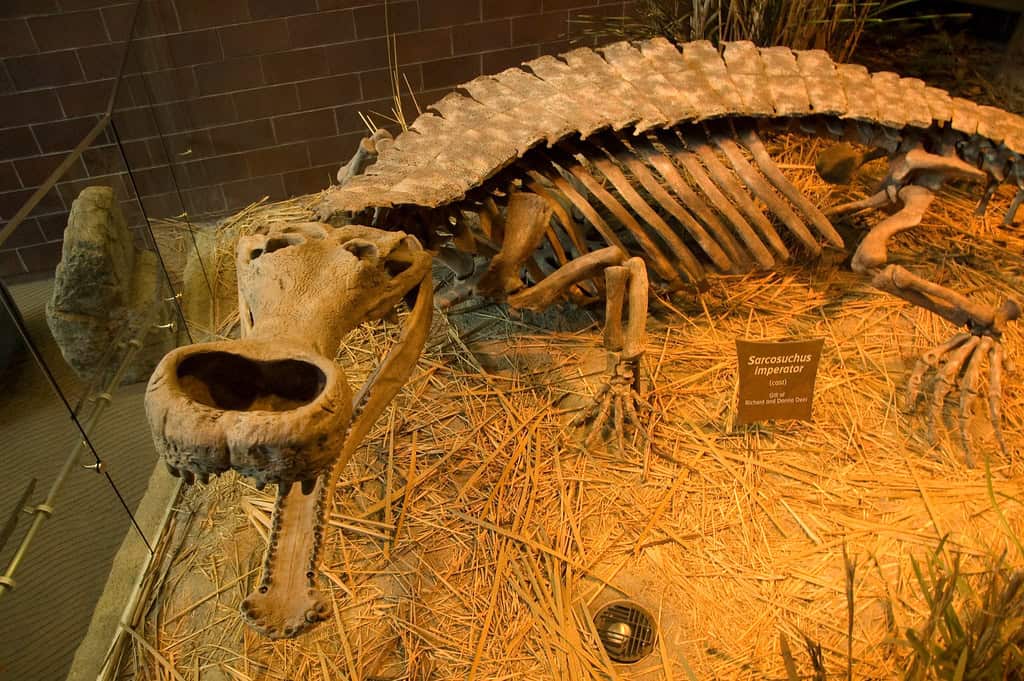
Fossil evidence and comparative anatomy suggest that Sarcosuchus was an ambush predator with a feeding strategy similar to modern crocodilians, but capable of taking down much larger prey. Its massive jaws contained over 100 teeth, each designed for grabbing and holding rather than cutting or tearing. Scientists believe that like today’s crocodiles, Sarcosuchus would lie in wait at the water’s edge, lunging with explosive force to capture unsuspecting prey.
Given its tremendous size and strength, it could likely have preyed upon dinosaurs, including medium-sized sauropods and theropods. After capturing prey, it would have employed the infamous “death roll”—a spinning maneuver used by modern crocodilians to dismember prey too large to swallow whole. The sheer force of Sarcosuchus’s bite would have been astronomical, estimated to be several times more powerful than that of a Tyrannosaurus rex.
Growth and Longevity

One of the most fascinating aspects of Sarcosuchus is how it achieved its enormous size. Studies of growth rings in fossilized bones, similar to tree rings, suggest that these prehistoric crocodilians had extended growth periods. Unlike modern crocodiles that reach adult size in about 10 years, Sarcosuchus likely continued growing for 50-60 years or more. This extended growth period allowed it to reach dimensions far beyond what we see in crocodilians today.
Researchers estimate that young Sarcosuchus hatchlings would have been similar in size to modern crocodile hatchlings, around 12 inches (30 cm) in length, but would have grown at a rate of about 8-12 inches (20-30 cm) per year for decades. This continuous growth throughout their lifespan helps explain how they achieved such tremendous proportions that dwarf modern species.
Fossil Distribution and Notable Specimens

Sarcosuchus fossils have primarily been found in two regions: the Elrhaz Formation in Niger and the Bahariјa Formation in Egypt. The most complete specimens come from expeditions led by Paul Sereno in the Tenere Desert of Niger between 1997 and 2000. One particular specimen, nicknamed “SuperCroc,” included a nearly complete skull and partial skeleton, providing unprecedented insights into the creature’s anatomy.
This remarkable specimen now resides in the National Geographic Society’s museum and continues to be one of the most impressive crocodilian fossils ever discovered. Additional fragments have been found across other parts of North Africa, suggesting a wide distribution across the ancient river systems that once flowed through what is now the Sahara Desert. Each new discovery has helped paleontologists refine their understanding of this magnificent prehistoric predator.
Evolutionary Significance
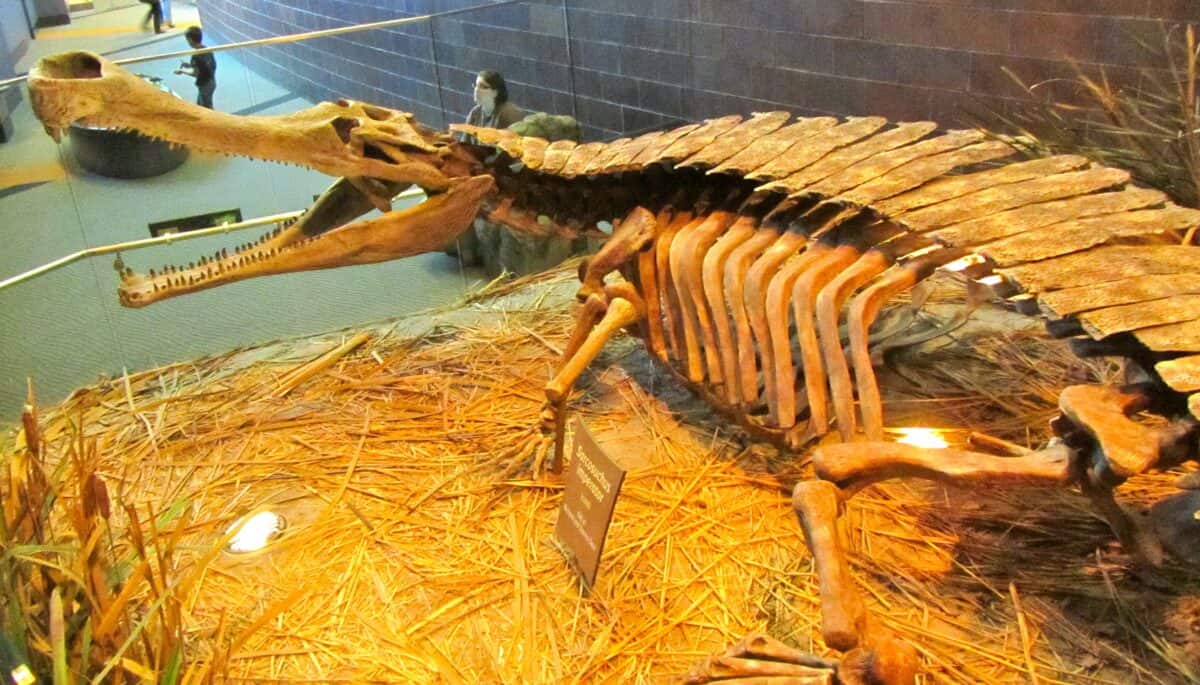
Sarcosuchus belongs to a group called Pholidosauridae, which were distinct from but related to modern crocodilians. This family of prehistoric crocodile-like reptiles diverged from the lineage that would eventually lead to today’s crocodiles and alligators. The evolutionary position of Sarcosuchus offers fascinating insights into crocodilian evolution and adaptation.
Despite its superficial resemblance to modern crocodiles, Sarcosuchus represents a separate evolutionary experiment in giant crocodilian anatomy. Its existence demonstrates that crocodile-like reptiles were capable of evolving to much larger sizes than we see today, raising questions about what ecological or physiological factors might limit the size of modern crocodilians. Some scientists theorize that metabolic constraints or competition with other large predators may explain why today’s crocodilians never reach the immense proportions of their prehistoric relatives.
Why Modern Crocodilians Are Smaller

The stark size difference between Sarcosuchus and modern crocodilians raises an intriguing question: why don’t today’s crocodiles grow as large? The answer likely lies in a combination of environmental, ecological, and evolutionary factors. First, the Early Cretaceous period featured warmer global temperatures and higher atmospheric oxygen levels, potentially supporting larger body sizes. Second, the ecosystems where Sarcosuchus lived had abundant prey resources, including large dinosaurs, providing sufficient energy to sustain such massive predators.
Third, competition with other large predators may have driven selection for increased size in Sarcosuchus. Finally, modern crocodilians face human hunting pressure and habitat restrictions that may prevent them from reaching their maximum potential size. Additionally, evolutionary changes in growth rates and metabolism might mean that modern crocodilians simply lack the genetic programming to grow to such extreme dimensions, regardless of environmental conditions.
Reconstructing Sarcosuchus: Challenges and Methods
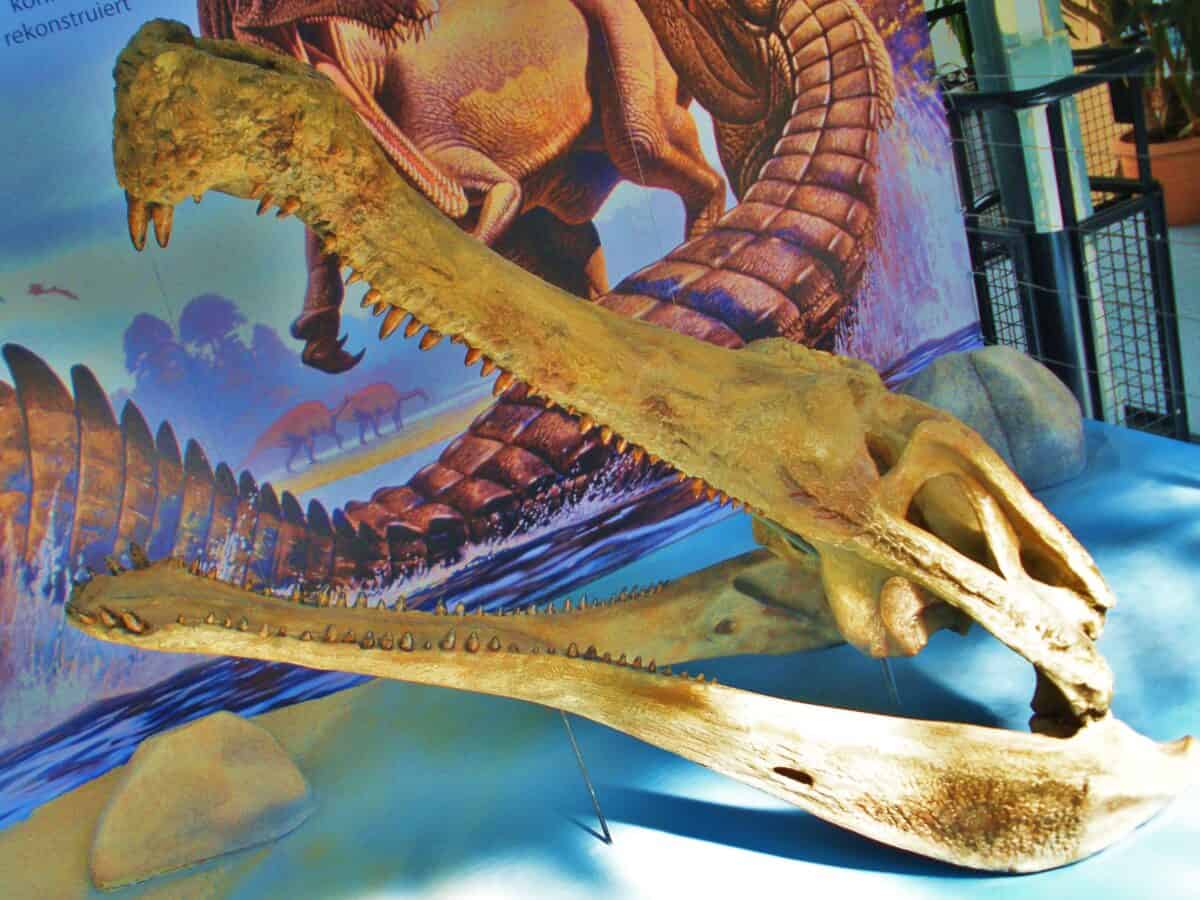
Reconstructing extinct animals based on fossil evidence is always challenging, and Sarcosuchus is no exception. Paleontologists use several methods to build accurate representations of this prehistoric giant. They start with comparative anatomy, examining the fossil bones and comparing them to modern crocodilians to understand structure and function. They employ allometric scaling—mathematical relationships between body parts—to estimate overall size from partial remains.
Digital modeling has revolutionized this process, allowing scientists to create 3D models that account for muscle attachments, joint movements, and biomechanical constraints. Soft tissue reconstruction remains more speculative, as features like skin texture and color must be inferred from modern relatives. Additionally, paleontologists collaborate with artists specializing in prehistoric life to create visualizations that balance scientific accuracy with artistic interpretation. These reconstructions continue to evolve as new fossil evidence and analytical techniques emerge.
Other Prehistoric Giant Crocodilians
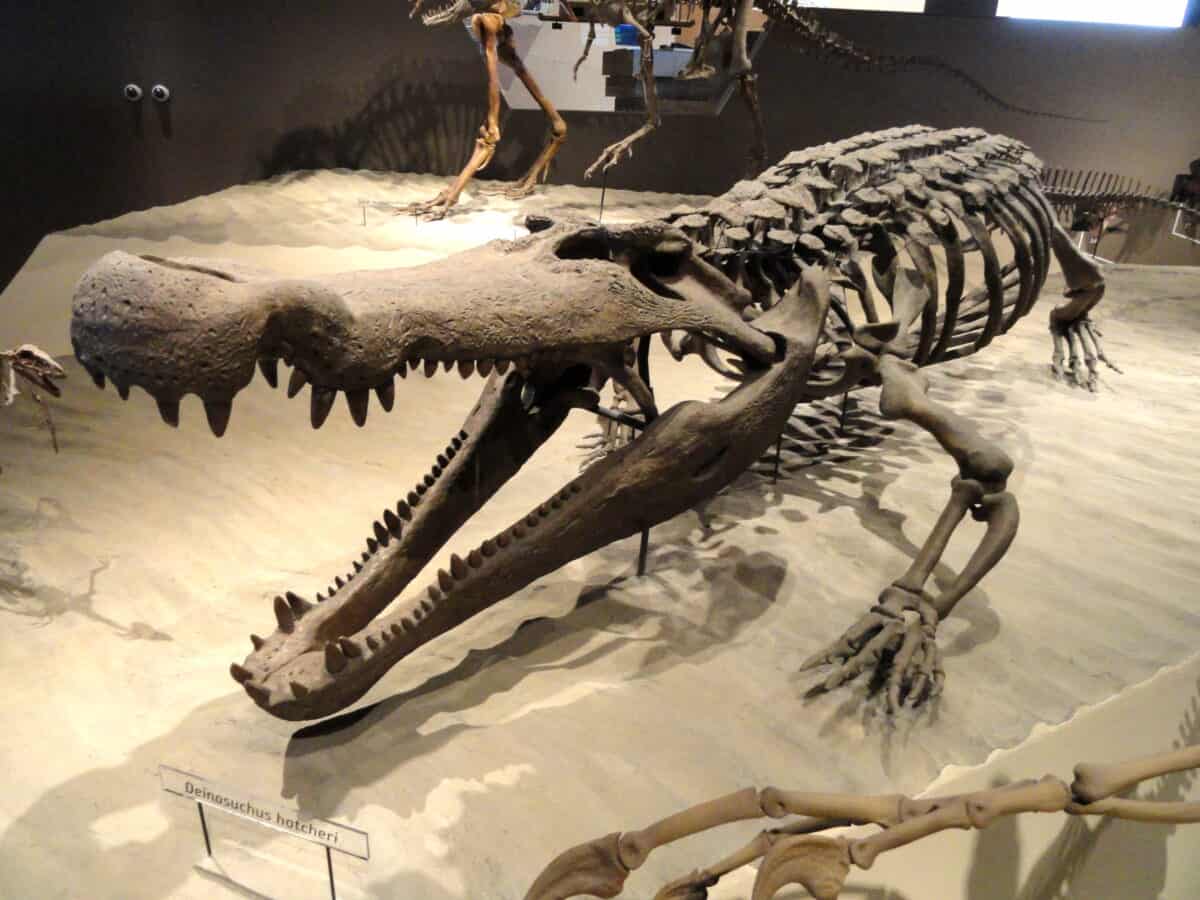
While Sarcosuchus stands as perhaps the most famous prehistoric giant crocodilian, it wasn’t the only massive crocodile-like predator to roam ancient Earth. Deinosuchus, which lived in North America during the Late Cretaceous period (about 82-73 million years ago), reached lengths of up to 35 feet (10.6 meters) and may have weighed as much as 8 tons. Purussaurus, a giant caiman relative from the Miocene epoch in South America (8-5 million years ago), grew to similar proportions with some estimates suggesting lengths of 41 feet (12.5 meters).
Rhamphosuchus, from the Miocene of India, was once thought to reach lengths of 50 feet (15 meters), though more recent estimates suggest a more modest but still impressive 26-33 feet (8-10 meters). These diverse giant crocodilians evolved independently across different continents and time periods, demonstrating that the crocodilian body plan has repeatedly produced megapredators throughout evolutionary history.
Cultural Impact and Public Fascination

Since its detailed description by paleontologists in the early 2000s, Sarcosuchus has captured the public imagination and featured prominently in documentaries, museum exhibitions, and popular science literature. National Geographic’s 2002 documentary “SuperCroc” introduced millions of viewers to this prehistoric giant and the scientific detective work behind its discovery. Life-sized models of Sarcosuchus have become centerpiece attractions at natural history museums worldwide, often eliciting gasps from visitors confronted with the sheer scale of this ancient predator.
The image of dinosaurs being hunted by a crocodile larger than a bus challenges our perceptions of prehistoric ecosystems and hierarchies. Sarcosuchus has also found its way into various forms of entertainment media, appearing in documentary series like “Planet Dinosaur” and inspiring creatures in video games and fiction. This cultural footprint demonstrates how certain prehistoric animals transcend scientific interest to become icons that shape our collective understanding of Earth’s ancient past.
Conclusion: Titans of a Lost World
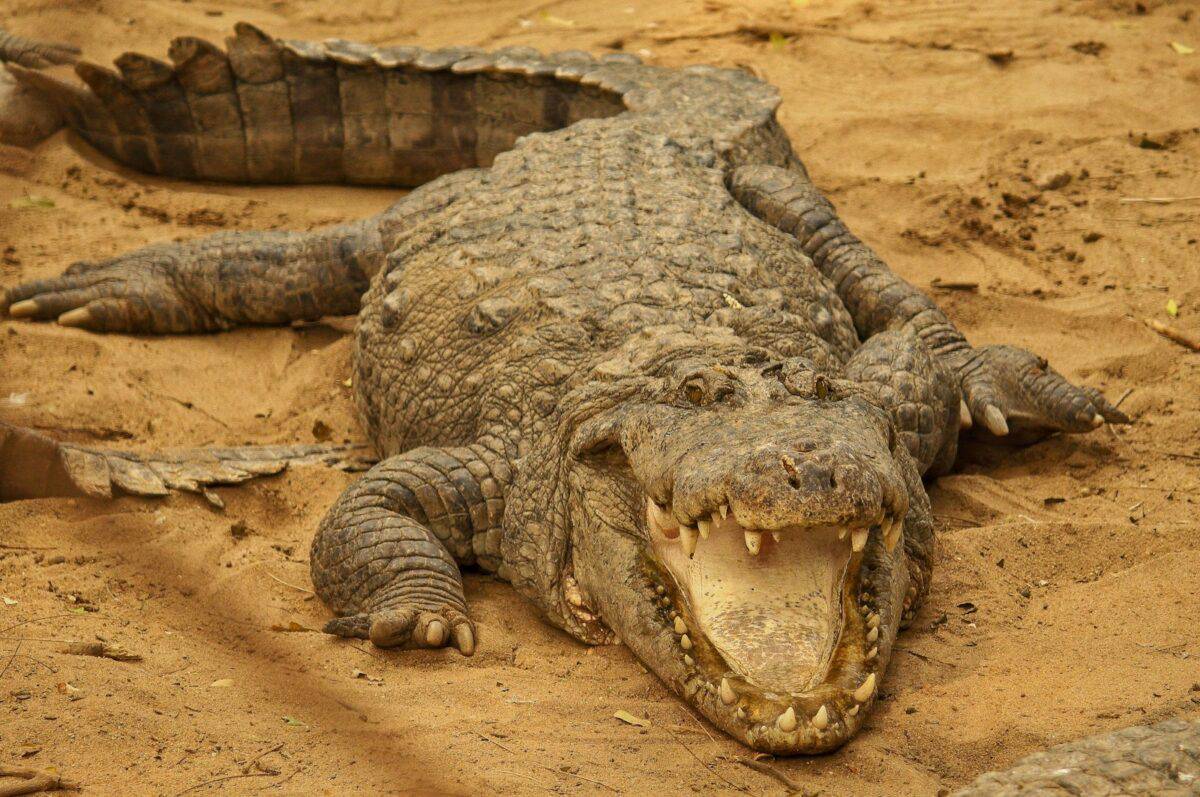
Sarcosuchus imperator stands as a testament to the astonishing diversity and scale of life throughout Earth’s history, reminding us that today’s natural world represents only a snapshot of the planet’s biological potential. This colossal crocodilian, with its 40-foot length and 10-ton weight, dominated its ecosystem in ways that no modern reptile can match, leaving us to marvel at the evolutionary possibilities that produced such magnificent creatures.
As paleontological techniques continue to advance, we may uncover even more details about how this prehistoric giant lived, hunted, and eventually disappeared from our planet. The study of Sarcosuchus and other prehistoric giants not only satisfies our curiosity about Earth’s past but also provides valuable insights into topics ranging from evolutionary biology to climate change, continually enriching our understanding of life’s grand narrative.
- This Massive Crocodile Fossil Dwarfs Anything Alive Today - August 15, 2025
- From Symbol to Supper: The Cultural Journey of the Chicken - August 15, 2025
- The Lizard That Brought Fire: Aboriginal Australian Legends - August 15, 2025

